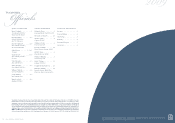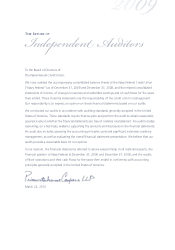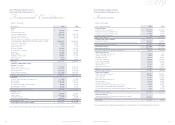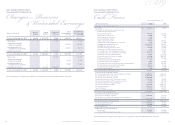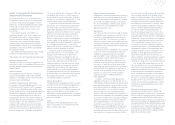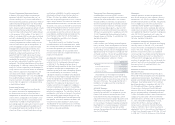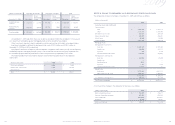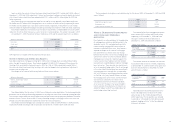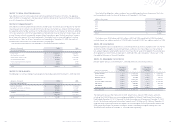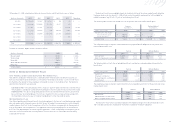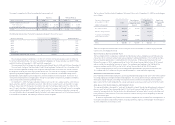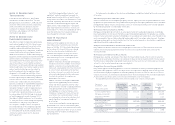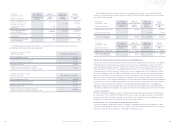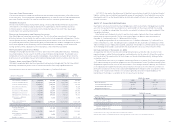Navy Federal Credit Union 2009 Annual Report Download - page 16
Download and view the complete annual report
Please find page 16 of the 2009 Navy Federal Credit Union annual report below. You can navigate through the pages in the report by either clicking on the pages listed below, or by using the keyword search tool below to find specific information within the annual report.
Troubled Debt Restructurings
A troubled debt restructuring (TDR) is a loan in
which Navy Federal has granted a concession to the
member due to the deterioration in the member’s
financial condition. Furthermore, the concession is
one that Navy Federal would not otherwise consider
in the normal course of business. The types of con-
cessions that Navy Federal grants as part of a TDR
include term extensions and interest rate reductions.
TDR loans are accounted for in accordance with ASC
310-40, Troubled Debt Restructurings by Creditors
(formerly known as SFAS No. 15 and SFAS No. 114).
See Note 4 for details.
Fixed Assets
Land is carried at cost. Building, leasehold improve-
ments, furniture, fixtures and equipment are carried
at cost, less accumulated depreciation and amortiza-
tion. Buildings, furniture, fixtures and equipment are
depreciated using the straight-line method over their
estimated useful lives. The cost of leasehold improve-
ments is amortized over the lease term or the useful
life of the improvement, whichever is shorter.
Navy Federal uses the straight-line method to
account for its operating leases. Under this method,
Navy Federal divides the total contractual rent by the
total term of the lease. The average monthly rent is
recorded as rent expense and the remaining rent
amount is deferred.
NCUSIF Deposit
The deposit in the National Credit Union Share
Insurance Fund (NCUSIF) is in accordance with the
Federal Credit Union Act and the National Credit
Union Administration (NCUA) regulations, which
require the maintenance of a deposit by each insured
credit union in an amount equal to one percent of
its insured shares. The deposit would be refunded to
Navy Federal if its insurance coverage is terminated,
it converts to insurance coverage from another
source or the operations of the fund are transferred
from the NCUA Board.
Goodwill
Goodwill represents the excess of purchase price
over the fair value of net assets acquired in business
combinations. ASC 350-20, Intangibles—Goodwill
and Other (formerly known as SFAS No. 142), provides
that intangible assets with finite useful lives be
amortized and that goodwill and intangible assets
with indefinite lives not be amortized, but rather be
tested at least annually for impairment. Navy Federal
tests goodwill for impairment quarterly in compliance
with ASC 350-20. Impairment exists when the
carrying amount of the goodwill exceeds its implied
fair value. See Note 10 for details.
Derivative Financial Instruments
In compliance with ASC 815, Derivatives and Hedging
(formerly known as SFAS No. 133), all derivative
financial instruments are recognized on the balance
sheet at fair value. Changes in the fair value of
derivative financial instruments are recorded in
current earnings. Navy Federal owned the following
derivative financial instruments at December 31,
2009 and 2008: mortgage loan commitments to
members at specified interest rates and forward sales
contracts to offset the risk of making the mortgage
loan commitments at specified interest rates.
See Note 6 for details.
Pension Accounting and Retirement
Benefit Plans
Navy Federal has defined benefit pension plans,
401(k) and 457(b) savings plans and a non-qualified
supplemental retirement plan. Navy Federal also
provides a contributory group medical plan for retired
employees. Navy Federal accounts for its defined
benefit pension plans in accordance with ASC 715-
30, Defined Benefit Plans—Pension subtopic of
Compensation—Retirement Benefits (formerly
known as SFAS No. 87). Non-pension postretirement
benefits are accounted for in accordance with ASC
715-60, Defined Benefit Plans—Other Postretirement
subtopic of Compensation—Retirement Benefits
(formerly known as SFAS No. 106). As of December
31, 2007, Navy Federal adopted ASC 715-20,
Defined Benefit Plans—General subtopic of
Compensation—Retirement Benefits (formerly
known as SFAS No. 158). In 2004, Navy Federal
adopted ASC 230-10, Presentation of the Statement
of Cash Flows (formerly known as SFAS No. 132) and
in 2009, ASC 715-20-50, Disclosures of the Defined
Credit Enhanced Mortgage Loans
In February 2004, Navy Federal entered into an
agreement with NFFG and Charlie Mac, LLC, an
investor subsidiary of U.S. Central Credit Union, in
which Charlie Mac purchases up to $200.0 million of
credit enhanced mortgage loans from Navy Federal
while Navy Federal retains the mortgage servicing
rights. Should a credit enhanced loan default, Charlie
Mac will recover the loan amount from NFFG. The
maximum total credit enhancement liability allowed
in this agreement is $8.5 million. Of that total, $1.0
million is set aside by NFFG as non-current restricted
cash with a designated financial institution. For the
remaining amount of $7.5 million, Navy Federal
issued an irrevocable transferable standby letter of
credit to Charlie Mac as part of the agreement. In
2004, the aggregate amount of credit enhanced
mortgage loans purchased by Charlie Mac had
reached the $200.0 million limit. At the time of
origination, all loans purchased pursuant to the
agreement had FICO credit scores, loan-to-value
ratios and debt-to-income ratios greater than those
required by the agreement. During 2009 and 2008,
no new loans were sold to Charlie Mac under this
agreement. The total principal balance of these loans
as of December 31, 2009 and 2008 was $91.5 million
and $122.7 million, respectively. As of December 31,
2009, there was an immaterial amount of delinquent
loans under this agreement. Navy Federal has not
accrued an estimated loss regarding the credit
enhanced mortgage loans for it is less than probable
that a liability had been incurred at the date of the
financial statements. Any liability reasonably expected
to result from this agreement is not expected to be
material to Navy Federal.
Loans and Leases
Loans, except for mortgage loans awaiting sale,
are stated at the amount of unpaid principal less
an allowance for loan losses. Interest on loans is
recognized on an accrual basis except for credit card
interest which is recognized on the member’s state-
ment date. Interest on loans is calculated using the
simple-interest method on the principal amount
outstanding except for credit cards. Interest on credit
cards is calculated by applying the periodic rate to
the average daily balance outstanding. Accrual of
interest on all loans is discontinued where manage-
ment believes collectibility is uncertain or payments
of principal or interest are past due by more than
90 days. All interest accrued but not collected on
loans that are placed in non-accrual status is reversed
against interest income. The interest on these loans is
accounted for on the cash basis until the loans return
to accrual status. Loans are returned to accrual status
when all the principal and interest amounts contrac-
tually due are brought current and future payments
are reasonably assured. Fees and costs for loan and
lease products are deferred and amortized over the
life of the loans under ASC 310-20, Receivables—
Non-refundable Fees and Other Costs (formerly
known as SFAS No. 91).
Navy Federal currently uses the direct financing
method to account for all automobile leases. Under
this method, lease contract receivables are the total
minimum lease payments plus residual value of
the leased automobiles, net of unearned interest
revenue. Interest revenue is recognized monthly on
receipt of rental payment.
Allowance for Loan Losses
Navy Federal accrues estimated losses in accordance
with ASC 450-10, Contingencies (formerly known
as SFAS No. 5). The allowance for loan losses is
established through a provision for loan losses charged
to expense. Loan principal is charged against the
allowance for loan losses when management believes
that the collectibility of the amount is unlikely;
subsequent recoveries are credited to the allowance
for loan losses. Navy Federal’s loan portfolio consists
mainly of large groups of smaller balance homo-
geneous loans that are collectively evaluated for
impairment. The allowance for loan losses is main-
tained at a level that, in management’s judgment, is
sufficient to absorb losses inherent in the portfolio,
based on evaluations of the collectibility of loans and
prior loan loss experience. The evaluations take into
consideration such factors as changes in the value of
loans outstanding, prior history of charge-offs and
recoveries, overall delinquency and delinquencies by
loan product, and current economic conditions and
trends that may affect a borrower’s ability to pay.
The allowance for loan and lease losses is reviewed
on a monthly basis and the provision that is charged
to expense is adjusted accordingly.
Navy Federal Credit Union
8 9
2009 Financial Section
2009
Useful Life
Buildings 40 years
Furniture and equipment 5 to 7 years
Computer equipment 2 to 5 years
Computer software 5 years






